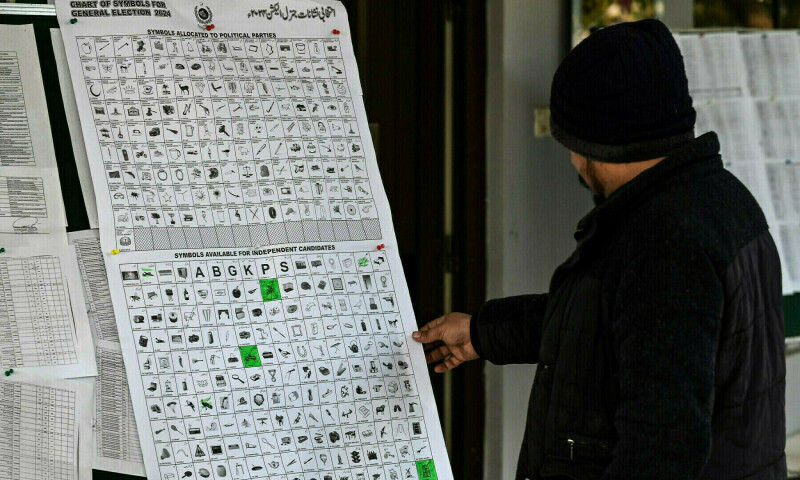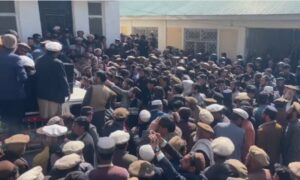ISLAMABAD: None of the candidates who won last year’s general elections secured the support of more than 50 per cent of voters registered in their constituencies, stated Free and Fair Election Network (Fafen), blaming the existing winner-takes-it-all model for fragmented electoral outcomes.
On only 69 or 26pc of all National Assembly seats, the winning candidates secured the support of more than half of all polled votes, said Fafen — a civil society network dedicated to strengthen democracy through oversight of electoral, parliamentary and governance processes — in its analysis ‘Representation in Pakistan’s Elections (2002-24)’.
The report underscored “systemic inadequacies” which result in legislatures that don’t align with voters’ intent.
These issues result in political instability by eroding public trust in electoral outcomes, the report stated.
Fafen analysis shows most lawmakers didn’t secure 50pc of registered or polled votes
Fafen called for immediate reforms to the First-Past-the-Post (FPTP) system to “enhance the representative aspects of elections”.
Fafen’s analysis of the last five general elections since 2002 showed “persistent representation gaps”.
The results of the 2024 general elections showed that none of the winning candidates in 265 NA constituencies got more than 50pc of registered votes.
At 202 constituencies (76pc), the winners were supported by less than 25pc of registered voters, while the proportion on the remaining 63 (24pc) constituencies was between 25pc and 50pc.
The winners in 69 (26pc) National Assembly constituencies secured more than 50pc of the polled votes, while at the remaining 196 (74pc) constitutes, winning candidates secured less than half of the polled votes.
Hence, the National Assembly resulting from last year’s elections enjoyed the support of only 21pc of registered voters and 45pc of votes who cast their ballot.
The outcome of provincial assemblies’ elections showed similar trends.
Of the 590 constituencies of all four Sindh, Punjab, Balochistan and Khyber Pakhtunkhwa assemblies, 499 or 85pc had winners securing less than 25pc of registered voters’ support.
Meanwhile, 89 constituencies (15pc) saw winners secure between 25pc and 50pc of all registered votes and only two had this proportion over 50pc.
In terms of polled votes, 466 (79pc) of constituencies had winners securing between 25pc and 50pc of votes. Winner’s share of polled votes exceeded 50pc in 107 (18pc) constituencies and only 17 (3pc) constituencies had a winner’s share of polled votes below 25pc.
Historic trends
The trend of fragmented representation due to systemic inefficiencies remained consistent during the last five general elections, the analysis revealed.
In 2002, the winners of National Assembly seats represented only 47pc of polled votes. The proportion peaked at 50pc in 2008, but fell to 48pc in 2013 and 43pc in 2018.
The proportion in the 2024 election was 45pc.
The proportion of representation in terms of registered voters paints an even dismal picture.
In GE-2002, the proportion of all members’ votes constituted 20pc of the registered voters. It increased to 22pc in 2008, 26pc in 2013 but declined to 22pc and 21pc in 2018 and 2024, respectively.
Low turnout
The report identified low voter turnout as a big concern, as the FPTP system “exacerbates the crisis” by rewarding candidates who secure the most votes in a constituency, regardless of whether they achieve majority support.
The results since 2002 showed that even though the absolute number of votes polled has increased steadily, from 30 million in 2002 to 61.2 million in 2024, voter turnout has fluctuated, peaking at 54pc in 2013 before declining to 48pc in 2024.
Voter disengagement is reflected in the growing gap between those who did not vote and those who did, the report added.
While 61m voters came out to vote, over 66m registered voters abstained from voting in 2024.
Moreover, the choices of 53pc of the 61m who voted were not represented in the assembly formed following the elections.
“These numbers highlight the representation deficits of the FPTP system,” it said.
Reforms
Fafen said the FPTP model is the simplest and most cost-effective electoral system.
However, concerns regarding its representation deficit have led to calls for reforms to enhance the representative aspects of elections.
The report added that several countries, including India and the United Kingdom, have debated the shortcomings of the system.
“Similarly, Pakistan’s FPTP system faces systemic concerns, along with the additional element of declining turnout in recent elections.”
The report added that the distribution of polled votes among all candidates shows that elections are becoming more competitive due to the rising number of political parties and independent candidates.
Due to the abundance of options on the ballot, “voters choices have become more diversified”, Fafen said adding that in its current form, the FPTP’s systemic limitations “do not account for votes cast for losing candidates”.
The report emphasised the need for an “informed and constructive debate” on the election system and urged the parliament to lead the reforms to enhance voter engagement and ensure more representative outcomes.
Published in Dawn, February 24th, 2025
- Desk Reporthttps://foresightmags.com/author/admin/










